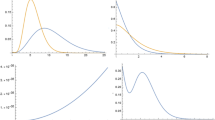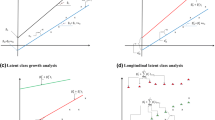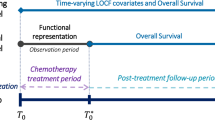Abstract
We consider a novel class of semiparametric joint models for multivariate longitudinal and survival data with dependent censoring. In these models, unknown-fashion cumulative baseline hazard functions are fitted by a novel class of penalized-splines (P-splines) with linear constraints. The dependence between the failure time of interest and censoring time is accommodated by a normal transformation model, where both nonparametric marginal survival function and censoring function are transformed to standard normal random variables with bivariate normal joint distribution. Based on a hybrid algorithm together with the Metropolis–Hastings algorithm within the Gibbs sampler, we propose a feasible Bayesian method to simultaneously estimate unknown parameters of interest, and to fit baseline survival and censoring functions. Intensive simulation studies are conducted to assess the performance of the proposed method. The use of the proposed method is also illustrated in the analysis of a data set from the International Breast Cancer Study Group.




Similar content being viewed by others
References
Alam K, Maity A, Sinha SK, Rizopoulos D, Sattar A (2021) Joint modeling of longitudinal continuous, longitudinal ordinal, and time-to-event outcomes. Lifetime Data Anal 27:64–90
Chen X, Hu T, Sun J (2017) Sieve maximum likelihood estimation for the proportional hazards model under informative censoring. Comput Stat Data Anal 112:224–234
Chen YH (2010) Semiparametric marginal regression analysis for dependent competing risks under an assumed copula. J R Stat Soc B 72:235–251
Chen YH (2012) Maximum likelihood analysis of semicompeting risks data with semiparametric regression models. Lifetime Data Anal 18:36–57
Chi Y, Ibrahim JG (2006) Joint models for multivariate longitudinal and multivariate survival data. Biometrics 62:432–445
Cho W, Liu Y (2021) A parallel evolutionary multiple-try metropolis Markov chain Monte Carlo algorithm for sampling spatial partitions. Stat Comput 31:10
De Gruttola V, Tu XM (1994) Modelling progression of CD4-lymphocyte count and its relationship to survival time. Biometrics 50:1003–1014
Dierckx P (1993) Curve and surface fitting with splines. Clarendon, London
Elashoff R, Li G, Li N (2008) A joint model for longitudinal measurements and survival data in the presence of multiple failure types. Biometrics 64:762–771
Faucett CL, Thomas DC (1996) Simultaneously modelling censored survival data and repeatedly measured covariates: a Gibbs sampling approach. Stat Med 15:1663–1685
Gelman A, Meng XL, Stern H (1996) Posterior predictive assessment of model fitness via realized discrepancies. Stat Sin 6:733–807
Geman D, Geman S (1984) Stochastic relaxation, Gibbs distributions, and the Bayesian restoration of images. IEEE Trans Pattern Anal Mach Intell 6:721–741
Hafych V, Eller P, Schulz O, Caldwel A (2022) Parallelizing MCMC sampling via space partitioning. Stat Comput 32:56
Hastings WK (1970) Monte Carlo sampling methods using Markov Chains and their application. Biometrika 57:97–109
Henderson R, Diggle P, Dobson A (2000) Joint modeling of longitudinal measurements and event time data. Biostatistics 4:465–480
Huang X, Zhang N (2008) Regression survival analysis with an assumed copula for dependent censoring: a sensitivity analysis approach. Biometrics 64:1090–1099
Ibrahim J, Molenberghs G (2009) Missing data methods in longitudinal studies: a review. TEST 18:1–43
Ibrahim JG, Chen MH, Sinha D (2001) Criterion based methods for Bayesian model assessment. Stat Sin 11:419–443
Ibrahim JG, Chen MH, Sinha D (2002) Bayesian survival analysis. Springer, New York
International Breast Cancer Study Group (1996) Duration and reintroduction of adjuvant chemotherapy for nodepositive premenopausal breast cancer patients. J Clin Oncol 14:1885–1894
Kang K, Song X (2022) Consistent estimation of a joint model for multivariate longitudinal and survival data with latent variables. J Multivar Anal 187:104827
Köhler M, Umlauf N, Greven S (2017) Nonlinear association structures in flexible Bayesian additive joint models. Stat Med 30:4771–4788
Lagakos S (1979) General right censoring and its impact on the analysis of survival data. Biometrics 35:139–156
Lang S, Brezger A (2004) Bayesian p-splines. J Comput Graph Stat 13:183–212
Li Y (2009) Semiparametric maximum likelihood estimation in normal transformation models for bivariate survival data. Biometrika 95:947–960
Li Y, Lin X (2006) Semiparametric normal transformation models for spatially correlated survival data. J Am Stat Assoc 101:591–603
Ma L, Hu T, Sun J (2015) Sieve maximum likelihood regression analysis of dependent current status data. Biometrika 102:731–738
Mary C, Meyer (2008) Inference using shape-restricted regression splines. Ann Appl Stat 2:1013–1033
Metropolis N, Rosenbluth AW, Rosenbluth MN, Teller AH, Teller EJ (1952) Equation of state calculations by fast computing machines. J Biochem Biophys Methods 21:1087–1092
Nelsen RB (2006) An introduction to copulas (Springer series in statistics). Springer, New York
Proust-Lima C, Sene M, Taylor JM, Jacqmin-Gadda H (2014) Joint latent class models for longitudinal and time-to-event data: a review. Stat Methods Med Res 23:74–90
Rizopoulos D, Hatfield LA, Carlin BP, Takkenberg JJM (2014) Combining dynamic predictions from joint models for longitudinal and time-to-event data using Bayesian model averaging. J Am Stat Assoc 109:1385–1397
Ruppert D (2002) Selecting the number of knots for penalized splines. J Comput Graph Stat 11:735–757
Song H, Peng Y, Tu D (2017) Jointly modeling longitudinal proportional data and survival times with an application to the quality of life data in a breast cancer trial. Lifetime Data Anal 23:183–206
Song X, Wang CY (2008) Semiparametric approaches for joint modeling of longitudinal and survival data with time-varying coefficients. Biometrics 64:557–566
Tang A, Zhao X, Tang N-S (2017) Bayesian variable selection and estimation in semiparametric joint models of multivariate longitudinal and survival data. Biom J 59:57–78
Tang AM, Tang NS (2015) Semiparametric Bayesian inference on skew-normal joint modeling of multivariate longitudinal and survival data. Stat Med 34:824–843
Tang NS, Tang AM, Pan DD (2014) Semiparametric Bayesian joint models of multivariate longitudinal and survival data. Comput Stat Data Anal 77:113–129
Wolkewitz M, Allignol A, Schumacher M, Beyersmann J (2010) Two pitfalls in survival analyses of time-dependent exposure: a case study in a cohort of Oscar nominees. Am Stat 64:205–211
Wulfsohn MS, Tsiatis AA (1997) A joint model for survival and longitudinal data measured with error. Biometrics 53:330–339
Zhang H, Huang Y (2020) Quantile regression-based Bayesian joint modeling analysis of longitudinal-survival data, with application to an aids cohort study. Lifetime Data Anal 26:339–368
Zheng M, Klein JP (1995) Estimates of marginal survival for dependent competing risks based on an assumed copula. Biometrika 82:127–138
Zhu HT, Ibrahim JG, Chi YY, Tang NS (2012) Bayesian influence measures for joint models for longitudinal and survival data. Biometrics 68:954–964
Acknowledgements
The authors thank the Editor Prof. Mei-Ling Ting Lee and three referees for their insightful comments and constructive suggestions, which have substantially improved on the earlier versions of this paper.
Author information
Authors and Affiliations
Corresponding author
Ethics declarations
Conflict of interest
The authors have declared no conict of interest.
Additional information
Publisher's Note
Springer Nature remains neutral with regard to jurisdictional claims in published maps and institutional affiliations.
This work was partly supported by grants from the National Natural Science Foundation of China (Nos. 11961079, 12071416, 12271472, 12071414).
Supplementary Information
Below is the link to the electronic supplementary material.
Supplementary Materials:
The MATLAB programs for implementing parameter estimation of the proposed JMLS are available in the on-line supplementary material. (pdf 186KB)
Appendices
Appendix A: The conditional likelihood of survival submodel with dependent censoring
If neither true survival time nor censoring time can be observed for i-th individual before the follow-up termination time \(\tau\), i.e \(\varrho _i=0\), based on the monotonic semiparametric normal transformation (2.11), it is easy to obtain the following conditional likelihood for the i-th individual with \(\varrho _i=0\)
where \({\varvec{Z}}_{i}=(Z_{i1},Z_{i2})^{\!\top \!}\sim N_2({\varvec{0}},{\varvec{\varUpsilon }})\) with \({\varvec{\varUpsilon }}=\left( \begin{array}{cc} 1 &{} \rho \\ \rho &{} 1 \\ \end{array} \right) ,\) and \(z_{im}=\varPhi ^{-1}\{1-S_{im}(\tau )\}\) for \(m=1\) and 2.
If the survival time is observable, i.e \(\varrho _i=1\) and \(\delta _i=1\), it is easy to obtain the following joint probability density function for the i-th individual with \((\varrho _i,\delta _i)=(1,1)\)
where \({\widetilde{\varPhi }}(Z_{i2}|Z_{i1})=1-\varPhi (Z_{i2}|Z_{i1})\) with \(\varPhi (Z_{i2}|Z_{i1})\) being the conditional cumulative distribution function of \(Z_{i2}\) given \(Z_{i11}\), and \(\textrm{f}_{i1}(T_{i})=\lambda _{i1}(T_{i})S_{i1}(T_{i})\). Similarly, If the censoring time is observable, i.e \(\varrho _i=1\) and \(\delta _i=0\), it follows that
where \(\textrm{f}_{i2}(T_{i})=\lambda _{i2}(T_{i})S_{i2}(T_{i})\). By combining Eqs. (A.1)–(A.3), one has Eq. (2.12).
Appendix B: Second order partial derivatives about the conditional likelihood function of survival submodel with dependent censoring
In order to implement MH algorithm from posterior distributions, it is necessary to compute
where \(\widetilde{{\varvec{\theta }}}\) stands for \({\varvec{\varphi }}_m\), \({\varvec{\alpha }}_m\) or \({\varvec{\gamma }}_m\) in survival process (\(m=1\)) or censoring process (\(m=2\)), or \({\varvec{\beta }}_k\) or \({\varvec{b}}_i\) shared in longitudinal and survival (or censoring) process. Equation (A.4) involves the following second order partial derivatives (A.5–A.7):
where
\(Z_{i[-m]}\) denotes the vector obtained by deleting the m-th element from \({\varvec{Z}}_{i}\),
for \(m=j=1~\text {or}~2\), and
for \(m\ne j\), \(m,j\in \{1,2\}\), \({\textrm{d} Z_{im}}/{\textrm{d} S_{im}}=-{1}/{\phi (Z_{im})}\) and \({d^2 Z_{im}}/{d S_{im}^2}={Z_{im}}/{[\phi (Z_{im})]^2}\). In addition,
where
and
One can evaluate \(\frac{\partial ^2 \ln \{{\widetilde{\varPhi }}(Z_{i2}|Z_{i1})\}}{\partial \widetilde{{\varvec{\theta }}}\partial \widetilde{{\varvec{\theta }}}^{\!\top \!}}\) in the similar framework given above. Moreover,
where \(S_{im}=S_{im}(T_i)\) and \(\lambda _{im}=\lambda _{im}(T_i)\), which are specified respectively in (2.8) and (2.9),
and when \(\widetilde{{\varvec{\theta }}}\) respectively takes various parameter vector, \({\partial S_{im}}/{\partial \widetilde{{\varvec{\theta }}}}\) and \({\partial ^2 S_{im}}/{\partial \widetilde{{\varvec{\theta }}}\partial \widetilde{{\varvec{\theta }}}^{\!\top \!}}\) can be computed as follows:
where \(a^{\otimes 2}=aa^T\) for any vector a. Based on Eqs. (A.5)–(A.7), it is easy to calculate
and
Appendix C: Bayesian inference on JMLS with dependent censoring
To obtain Bayesian estimates of unknown parameters, baseline hazard functions and random effects in our considered JMLS with dependent censoring, the Gibbs sampler is employed to draw a sequence of random observations from the joint posterior distribution \(\pi ({\varvec{\theta }}, {\varvec{B}}|{\varvec{D}}, \rho )\) presented in Eq. (2.16). The block Gibbs sampler is conducted by iteratively sampling observations from the following conditional distributions: \(\pi ({\varvec{\theta }}_l|{\varvec{\theta }}_s, {\varvec{\theta }}_{\varepsilon }, {\varvec{B}}, {\varvec{D}}, \rho )\), \(\pi ({\varvec{\theta }}_s|{\varvec{\theta }}_l, {\varvec{B}}, {\varvec{D}}, \rho )\), \(\pi ({\varvec{\varOmega }}|{\varvec{B}})\) and \(\pi ({\varvec{B}}|{\varvec{\theta }}_l,{\varvec{\theta }}_s,{\varvec{D}}, \rho )\). The conditional distributions required in implementing the Gibbs sampler are presented as follows.
Block Gibbs Sampler (A): Conditional distribution related to \({\varvec{\theta }}_l\)
Let \({\varvec{\theta }}_l=\{{\varvec{\beta }}, {\varvec{\varSigma }}\}\), where \({\varvec{\beta }}=({\varvec{\beta }}_1,\ldots ,{\varvec{\beta }}_K)\) in which \({\varvec{\beta }}_k=(\beta _{k0},\beta _{k1},\ldots ,\beta _{kr})^{\!\top \!}\) for \(k=1,\ldots ,K\). From Eq. (2.16), the conditional distribution
is proportional to
where \({\varvec{\beta }}_{[-k]}\) is parameters’ matrix \({\varvec{\beta }}\) with the k-th column deleted. Because the above equation is not a familiar distribution, it is rather difficult to directly sample from the conditional distribution \(\pi ({\varvec{\beta }}_{k}|{\varvec{\theta }}_s, {\varvec{\beta }}_{[-k]}, {\varvec{\varSigma }},{\varvec{B}},{\varvec{H}}_{\beta _k},{\varvec{D}})\). Therefore, the well-known MH algorithm is adopted to simulate observations from the above given conditional distribution, which is implemented as follows. Given the current value \({\varvec{\beta }}_k^{(\ell )}\) at the \(\ell\)-th step, a new candidate \({\varvec{\beta }}_k\) is generated from the proposal distribution \(N_{p}({\varvec{\beta }}_k^{(\ell )},\sigma _{\beta _k}^2{\varvec{\varXi }}_{\beta _k})\) with \(\sigma _{\beta _k}^2\) set to control the acceptance rate, and then the drawn candidate \({\varvec{\beta }}_k\) is accepted with probability
where
with \(\sigma ^{kk}\) being the (k, k)-th entry of \({\varvec{\varSigma }}^{-1}\), and \({\partial ^2 \ln \{\textrm{Pr}(T_i, \varrho _i, \delta _i| {\varvec{b}}_i,\rho , {\varvec{\theta }}_s)\}}/{\partial {{\varvec{\beta }}_k}\partial {\varvec{\beta }}_k^{\!\top \!}}\) given in Appendix B.
From the prior distribution of \({\varvec{\varSigma }}\) and \({\varvec{\varepsilon }}_{ij}\sim N_K({\varvec{0}},{\varvec{\varSigma }})\), it is easily shown that
where \(N=\mathop {\sum }\limits _{i=1}^n n_i\).
Block Gibbs Sampler (B): Conditional distribution related to \({\varvec{\theta }}_s\)
Let \({\varvec{\theta }}_s=\{({\varvec{\alpha }}_{m},{\varvec{\gamma }}_{m},{\varvec{\varphi }}_{m}): m=1,2\}\). \({\varvec{\alpha }}_{m},{\varvec{\gamma }}_{m}\) and \({\varvec{\varphi }}_{m}\) can be iteratively sampled from their corresponding conditional distributions, which are given as follows. It follows from Eq. (2.16) that the conditional distributions \(\pi ({\varvec{\alpha }}_{m}|{\varvec{\beta }},{\varvec{\gamma }}_{m},{\varvec{\varphi }}_{m},\rho ,{\varvec{B}},{\varvec{D}},\rho )\) and \(\pi ({\varvec{\gamma }}_{m}|{\varvec{\beta }},{\varvec{\alpha }}_{m},{\varvec{\varphi }}_{m},\rho , {\varvec{B}},{\varvec{D}},\rho )\) are proportional to \(\prod _{i=1}^{n}\textrm{Pr}(T_i,\varrho _i, \delta _i| {\varvec{b}}_i, {\varvec{\theta }}_s,\rho )\). Similarly to drawing \({\varvec{\beta }}_k\), it is easy to sample from the above posterior distributions via MH algorithm, so the details are omitted.
Conditional distribution \(\pi ({\varvec{\varphi }}_{m}|{\varvec{\beta }},{\varvec{\alpha }}_{m},{\varvec{\gamma }}_{m},{\varvec{B}},{\varvec{D}},\rho )\) is proportional to
where \({\varvec{H}}_{\varphi _m}\) is a \((L+s) \times (L+s)\) second difference penalized matrix with rank \(L+s-2\) (Lang and Brezger 2004). Given the current value \({\varvec{\varphi }}_m^{(\ell )}\), it is usual to sample from the above posterior with MH algorithm, in which the truncated multivariate normal distribution \(\textrm{TMN}_{L+s}({\varvec{\varphi }}_m^{(\ell )},\sigma _{\varphi _m}^2{\varvec{\varXi }}_{\varphi _m}) \textrm{I}({\varvec{A}}_m{\varvec{\varphi }}_m>0)\) is adopted as the proposal distribution due to the linear constraints specified by Eq. (2.7), where \(\sigma _{\varphi _m}^2\) is set to control the acceptance rate and Fishery information matrix
with \({\partial ^2 \ln (\textrm{Pr}(T_i, \varrho _i, \delta _i| {\varvec{b}}_i,\rho , {\varvec{\theta }}_s))}/{\partial {{\varvec{\varphi }}_m}\partial {\varvec{\varphi }}_m^{\!\top \!}}\) given in Appendix B. However, to compute probability of acceptance, it is inevitable to involve high-dimensional integral, which may cause low-efficient sampling and inaccurate result, especially for large \(L+s\). Based on Gibbs sampler (Geman and Geman 1984), instead of sampling the whole \({\varvec{\varphi }}_m\) directly, we propose to sample each component of \({\varvec{\varphi }}_m\) one by one, which may achieve good sampling effect at cost of moderate computational time. Given the current j-th component \({\varphi }_{mj}^{(\ell )}\) in the \(\ell\)-th iterative, a new candidate \({\varphi }_{mj}\) is generated from the truncated normal \(\textrm{TN}({\varphi }_{mj}^{(\ell )}, \sigma _{m}^2{\varvec{\varXi }}_{\varphi _m}^{jj})\textrm{I}\{\varphi _{mj}\in (a_{mj}, +\infty )\}\) with \({\varXi }_{\varphi _m}^{jj}\) being the (j, j)-the entry of \({\varvec{\varXi }}_{\varphi _m}\) and \(\sigma _{m}^2\) set to control the acceptance rate, \(a_{mj}\) can be obtained via solving the inequalities \({\varvec{A}}_m{\varvec{\varphi }}_m>0\) in (2.7) with respect to \({\varphi }_{mj}\), and then the drawn candidate \({\varphi }_{mj}\) is accepted with probability
where \({\varvec{\varphi }}_{m[-j]}\) denotes \({\varvec{\varphi }}_{m}\) with the j-th component deleted.
The conditional distribution of the smoothing parameter \(\varsigma _m^2\) is given by
Block Gibbs Sampler (C): Conditional distribution related to random effects set \({\varvec{B}}\) and random effects covariance matrix \({\varvec{\varOmega }}\)
Conditional distribution \(\pi ({\varvec{b}}_{i}|{\varvec{\theta }}, {\varvec{\varOmega }}, {\varvec{D}}_i)\) is in proportion to
Similarly, the MH algorithm is used to sample \({\varvec{b}}_i\) from the above conditional distribution for \(i=1,\ldots ,n\). Based on that \({\varvec{b}}_i{\mathop {\sim }\limits ^{\mathrm{i.i.d.}}} N_{q}({\varvec{0}}, {\varvec{\varOmega }})\) and the prior specified in (2.13), it is readily seen that
Appendix D: Summaries about variables in the IBCSG data (Tang et al. 2017)
-
1. Four untransformed longitudinal QOL indicators
-
\(y_{1}\): physical well-being on a scale of zero (lousy) to hundred (good);
-
\(y_{2}\): mood on a scale of zero (miserable) to hundred (happy);
-
\(y_{3}\): appetite on a scale of zero (none) to hundred (good);
-
\(y_{4}\): perceived coping (How much effort does it cost you to cope with your illness?) on a scale of zero (a great deal) to hundred (none).
-
2. Observed event time \(T_{im}\) in survival submodel
-
\(T_{i}\): the monitored overall survival time, abbreviated as ‘OS’.
-
3. Covariates in JMLS
-
\(R_{i1}\): the number of positive nodes of the tumor, abbreviated as ‘#Positive nodes’;
-
\(R_{i2}\): three versus six initial cycles of oral cyclophosphamide, methotrexate and fluorouracil, abbreviated as ‘#Initital cycle’;
-
\(R_{i3}\): the reintroduction of three single courses of delayed chemotherapy, abbreviated as ‘Reintroduction’;
-
\(R_{i4}\): the interaction of the number of initial cycles and reintroduction, abbreviated as ‘#INIR’;
-
\(R_{i5}\): whether the residency is Switzerland, abbreviated as ‘Residency: Switzerland’;
-
\(R_{i6}\): whether the residency is Sweden, abbreviated as ‘Residency: Sweden’;
-
\(R_{i7}\): the age of premenopausal woman, abbreviated as ‘#Age’;
-
\(R_{i8}\): the estrogen receptor (ER) status (negative/positive), abbreviated as ‘ER’.
Rights and permissions
Springer Nature or its licensor (e.g. a society or other partner) holds exclusive rights to this article under a publishing agreement with the author(s) or other rightsholder(s); author self-archiving of the accepted manuscript version of this article is solely governed by the terms of such publishing agreement and applicable law.
About this article
Cite this article
Tang, AM., Tang, NS. & Yu, D. Bayesian semiparametric joint model of multivariate longitudinal and survival data with dependent censoring. Lifetime Data Anal 29, 888–918 (2023). https://doi.org/10.1007/s10985-023-09608-5
Received:
Accepted:
Published:
Issue Date:
DOI: https://doi.org/10.1007/s10985-023-09608-5
Keywords
- Dependent censoring
- Joint model
- Longitudinal data
- Penalized-splines with linear constraints
- Survival data




